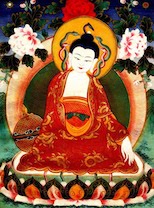Koso Wasan 3
Our teacher, Bodhisattva Nagarjuna,
Clarified the unexcelled dharma of the Great Vehicle;
Having attained the stage of joy,
He wholeheartedly recommended the nembutsu to all.
On Joy

In the essays on the Jodo Wasan, we have already discussed pramudita, the stage of joy. This is the forty-first rung on the ladder which characterises a bodhisattva's career and the first of the ten stages (Sk. bhumi), representing the aspirant's entry into the final course which takes one to the eventual attainment of a Buddha's full awakening.
In the Pure Land tradition the awakening of shinjin, (Sk. prasanna citta) is similar in effect and leads to the same result as pramudita. Shinran Shonin and his predecessors speak of the awakening of shinjin as bringing with it great joy.
In chapter nine of the Dasha Bhumi, Nagarjuna sets out the idea that faith is a possible alternative to the rigorous practice most bodhisattvas undertake. The idea that faith is able to carry an aspirant to eventual nirvana is based on a fundamental principle of the Buddha Dharma - no soul or ego (Sk. anatman). It is awakened in conjunction with the realisation of this 'sign' of truth (Sk. lakshana) at the first stage (pramudita) of the bodhisattva path - when both faith and awareness of anatman become fixed. This awareness also lies behind the arising of joy because it signifies the experience of being released from the illusion of self.
The joy that accompanies pramudita and faith in the Buddha Dharma is no quiescent, passive thing. It inspires one to 'leap and dance'.
In the term 'joy' (kangi), kan means to be gladdened in body and -gi means to be gladdened in mind. To rejoice, realising that one is assured of attaining what one shall attain, is called 'joy'.1
1: CWS, p. 362